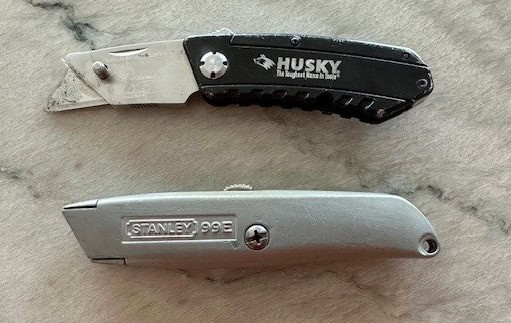A utility knife is a versatile tool commonly used in various DIY, craft, and construction projects. Designed for cutting a wide range of materials, including cardboard, plastic, and wood, the utility knife is an essential tool for precision work. Its compact size and replaceable blades make it a convenient option for tasks that require a sharp edge.
History of the Utility Knife
The utility knife has its roots in ancient cutting tools, but the modern version evolved in the early 20th century. Initially used primarily by workers in construction and manufacturing, the utility knife became more widespread as its design improved. The introduction of replaceable blades in the 1950s made the tool even more popular, leading to its adoption in households and various industries worldwide.
Different Types of Utility Knives
- Fixed-Blade Utility Knife: A solid, non-retractable blade ideal for heavy-duty cutting tasks.
- Retractable-Blade Utility Knife: Features a blade that can be extended or retracted, providing safety when not in use.
- Snap-Off Blade Utility Knife: Equipped with a segmented blade that can be snapped off to reveal a fresh, sharp edge.
- Folding Utility Knife: A compact option with a folding mechanism, making it easy to carry and store.
- Safety Utility Knife: Designed with additional safety features like a self-retracting blade to reduce the risk of accidents.
Utility Knife Key Features
- Blade Material: Typically made from stainless steel or carbon steel for durability and sharpness.
- Handle Design: Ergonomically designed handles for comfortable and safe use.
- Blade Storage: Some models include onboard blade storage for quick and easy replacement.
- Blade Length: Varies depending on the type, with common lengths being 2-4 inches.
- Safety Mechanisms: Features like retractable blades or blade locks for added safety.
Choosing the Right Utility Knife
Selecting the right utility knife depends on the specific tasks you plan to undertake. Consider the type of materials you’ll be cutting, the frequency of use, and the level of safety you require. For heavy-duty cutting, a fixed-blade or snap-off blade knife might be ideal, while a retractable or folding knife offers convenience and safety for lighter tasks.
Recommendations
Proper Use and Techniques
Using a utility knife properly ensures both efficiency and safety. Always cut away from your body and ensure the material being cut is securely held in place. When making long cuts, apply even pressure and use the full length of the blade. For detailed work, use a fresh, sharp blade to maintain precision.
Maintenance and Care
Regular maintenance of your utility knife extends its lifespan and ensures optimal performance. Clean the blade after each use to remove debris and prevent rust. Store the knife in a dry place and replace the blade as soon as it shows signs of dullness. For models with blade storage, ensure spare blades are kept sharp and ready for use.
Utility Knife Safety Tips
Safety is paramount when using a utility knife. Always wear cut-resistant gloves when handling the knife and ensure the blade is retracted or folded when not in use. Avoid using excessive force, as this can cause the blade to slip. Finally, dispose of used blades properly, as they can still pose a hazard.
Conclusion
The utility knife is an indispensable tool in any DIY toolkit, offering versatility and precision for a variety of cutting tasks. By choosing the right type, using proper techniques, and adhering to safety practices, you can maximize the effectiveness and longevity of your utility knife. Whether you’re a seasoned DIY enthusiast or a beginner, understanding the utility knife’s features and proper care will enhance your project outcomes.


